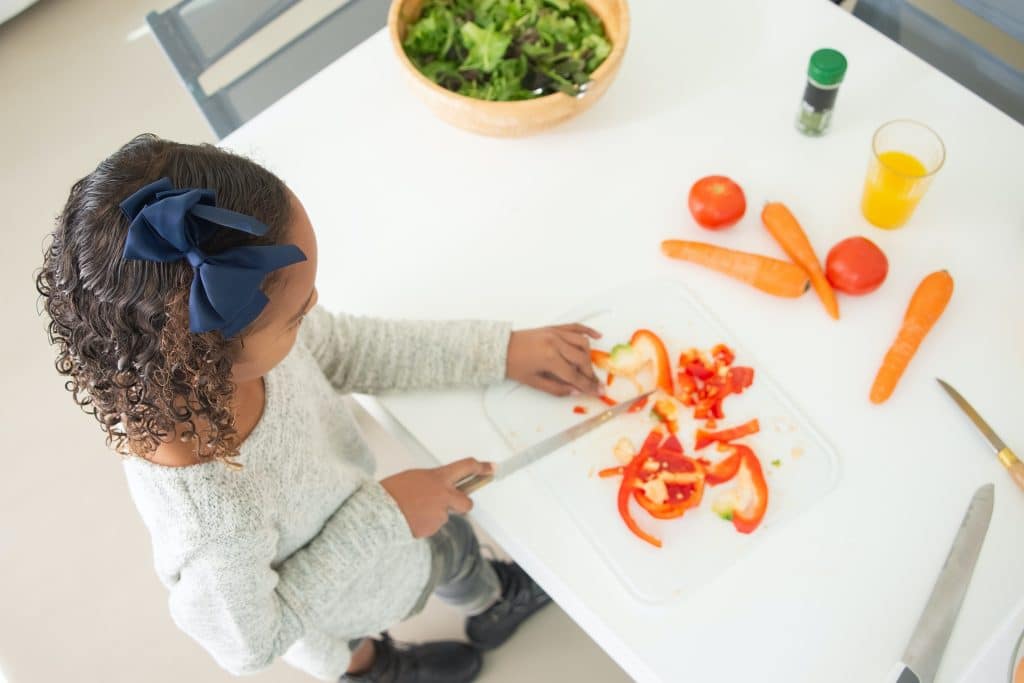Teaching kitchen knife safety to kids is essential for preventing accidents and building confidence in the kitchen. This guide provides simple steps to help your kids learn safe knife handling techniques.
Key Takeaways:
- Start with the basics by introducing kid-friendly knives.
- Teach proper cutting techniques and safety habits.
- Supervise and encourage your kids as they practice these skills.
How do you teach kitchen knife safety to kids? Start with age-appropriate knives, demonstrate proper techniques, and emphasize the importance of focus and safety at all times in the kitchen.
Table of Contents
Step 1: Start with Kid-Friendly Knives
When introducing kids to knife safety, it’s important to start with tools designed for their age group. Kid-friendly knives are typically made of plastic or have rounded edges, reducing the risk of accidents. Let your kids get comfortable using these knives before moving on to sharper tools.
Explain to your kids that these knives are just the beginning and that as they get better at handling them safely, they’ll be able to use more advanced tools. This approach builds their confidence and sets the foundation for learning proper techniques.
Step 2: Teach Proper Cutting Techniques
Once your kids are comfortable with their knives, it’s time to teach them the basics of cutting. Start with simple tasks like slicing soft fruits or vegetables. Show them how to hold the knife correctly, using a firm grip, and how to position their fingers to avoid cuts.
One helpful technique is the “claw grip,” where kids curl their fingers under while holding the food with their knuckles facing the knife. This keeps their fingertips out of harm’s way. Practice this grip with your kids until they feel confident using it every time they cut.
Step 3: Emphasize Safety Habits
As your kids become more skilled with knives, it’s crucial to instill good safety habits. Teach them to always focus on what they’re doing and to never rush when using a knife. Remind them that knives should be handled with respect and that they should never play with them.
Additionally, make sure your kids understand the importance of keeping their workspace clean and organized. A cluttered area can lead to accidents, so encourage them to clean up as they go and to always place the knife down safely when not in use.

Read more: How to Make a Bagel | A Guide for Kids
Step 4: Supervise and Support Practice
Practice makes perfect, and this is especially true when learning to use kitchen knives. Supervise your kids closely as they practice cutting different foods, providing guidance and correction as needed. Over time, you’ll see their skills and confidence grow.
As they improve, gradually introduce more challenging tasks and allow them to use sharper knives under supervision. Celebrate their progress and encourage them to keep practicing, reinforcing the idea that safe knife handling is a valuable skill.
Step 5: Reinforce the Importance of Focus and Patience
One of the most important lessons in kitchen knife safety is the value of focus and patience. Teach your kids that rushing or becoming distracted while using a knife can lead to accidents. Encourage them to take their time and to always be aware of their surroundings.
To help reinforce this lesson, set aside specific times for them to practice when there are no other distractions in the kitchen. This will help them develop good habits and ensure that they’re fully focused on the task at hand.
Why Kitchen Knife Safety Matters
Teaching kitchen knife safety is not just about preventing accidents; it’s also about empowering your kids to feel confident in the kitchen. By learning how to handle knives safely, they gain a valuable skill that will serve them for life.

Read more: Food Safety for Kids
Research shows that involving kids in cooking activities can boost their self-esteem and encourage healthy eating habits [source]. By teaching them proper knife skills, you’re helping them develop a sense of responsibility and independence.
Making Knife Safety Fun and Engaging
To keep your kids engaged while learning knife safety, try turning the lessons into a fun activity. For example, you could have a “cutting challenge” where they see how neatly they can slice a cucumber or carrot. This adds an element of fun while still emphasizing the importance of safety.
Another idea is to involve them in meal prep, letting them help with tasks like chopping vegetables for a salad or slicing fruit for a snack. The more involved they are, the more likely they are to take their knife skills seriously and practice them regularly.
Encouraging Consistent Practice
Consistency is key when it comes to learning any new skill, including kitchen knife safety. Encourage your kids to practice regularly, whether it’s helping with dinner prep or making their own snacks. The more they use their skills, the more confident and capable they’ll become.
Consider setting up a simple practice schedule where they can choose a task to work on each week. This helps keep the lessons fresh in their minds and gives them plenty of opportunities to build their skills over time.
Goally | 100+ Streaming Video Classes
Does your child need some extra guidance on building essential life skills? Goally’s skill building tablet for kids includes a TV app that has the most robust video library of skills training videos for kids. Ranging from content like “How to Brush Your Teeth” to “How to Make Friends at School,” we have dozens of interactive video lessons for kids with thinking and learning differences.

HERE’s a video explaining how to works.
Teaching kitchen knife safety to kids is an essential step in helping them become confident and capable in the kitchen. By following these steps and encouraging regular practice, you’ll set them up for success and ensure they develop lifelong skills in the kitchen.
Helpful Resources
FAQ’s About Kitchen Knife Safety
What is the safest type of knife for kids to use in the kitchen?
Kid-friendly knives with rounded edges are the safest option for young children.
At what age can kids start using kitchen knives?
Kids can start using kid-friendly knives under supervision around age five.
How can I teach my child to hold a knife properly?
Teach your child to use the "claw grip" to keep fingers safe while cutting.
What is the first step in teaching kitchen knife safety?
Start by introducing kid-friendly knives and practicing with soft foods.
How can I make kitchen knife safety fun for my child?
Turn knife skills into a game, like a slicing challenge with soft fruits or vegetables.
Emily is a seasoned blog writer for Goally, leveraging her extensive background in child psychology and special education to provide valuable insights and resources for parents. Her commitment to understanding and addressing the unique needs of these children, combined with her expertise in educational strategies, makes her a credible and empathetic voice for families.





